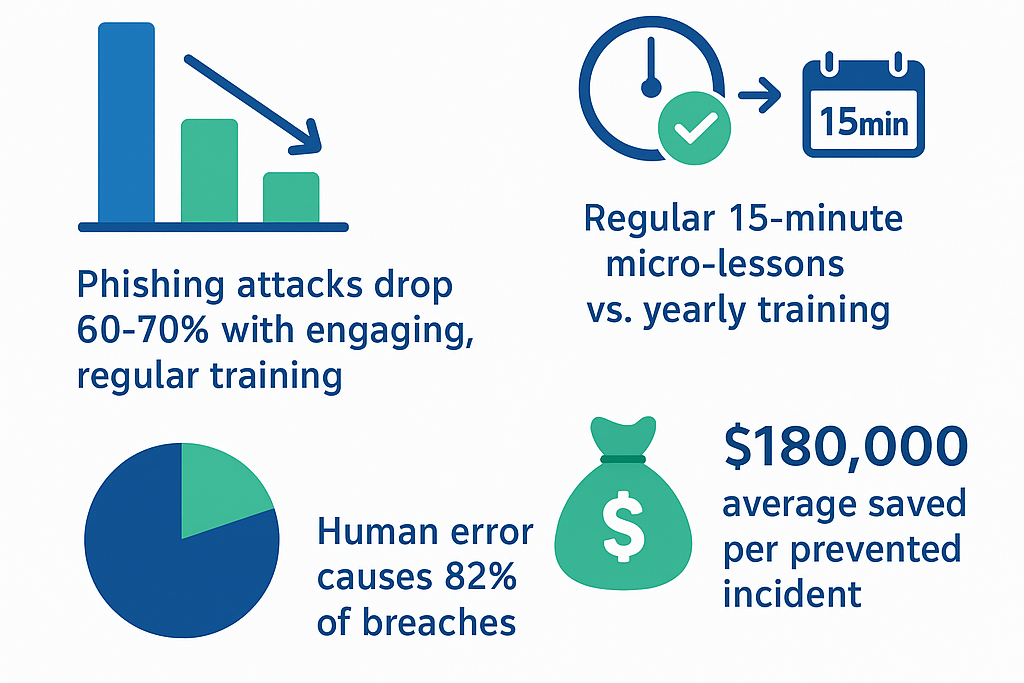Nobody wants to sit through another boring security video about not clicking suspicious links. That’s probably what half the workforce thinks when they hear “cybersecurity training.” Yet with phishing attacks hitting an average of 65% of organizations last year, companies keep pouring money into programs that employees mostly sleep through.
The real problem isn’t the training itself – it’s how organizations approach it. Good security awareness doesn’t come from checking boxes or watching dated videos. It comes from understanding how people actually learn and change their habits at work. Here’s what actually works, backed by real numbers and field-tested methods.
Key Takeaways
- Security training works best when it’s woven into the daily grind, not crammed into a yearly compliance module that everyone rushes through at the last minute.
- We’ve seen phishing attempts drop by 60% when companies invest in programs that actually get people’s attention, make them think, and connect to their real work challenges.
- Our team tracks everything from how many people show up to training sessions to whether they’re falling for our test phishing emails, because good data tells the real story of what’s working (and what’s not).
User Awareness Training Effectiveness: Core Concepts and Objectives
Most companies treat security training like a yearly chore, right up there with updating emergency contact forms. (1) That mindset needs to change. Real security awareness builds strong habits that stick around long after the training videos end.
Our security team has watched countless organizations throw money at fancy programs that didn’t move the needle – because they missed the point entirely.
Getting people to care about security takes more than slide decks and quizzes. When we work with clients, they’re often surprised to learn that human error causes about 82% of data breaches.
The good news? Teaching people to spot threats actually works. Companies that run solid awareness programs see measurable drops in successful phishing and spear phishing attacks, usually around 50-60% after six months.
Here’s what makes security training stick:
- Regular 15-minute micro-lessons that don’t overwhelm
- Real examples from recent breaches (like that hospital ransomware attack last month)
- Practice scenarios employees might actually face
- Clear steps for reporting suspicious activity
Nobody likes sitting through boring compliance training, but security awareness protects more than just company data. We’ve seen how good training helps people protect their personal information too.
That’s probably why healthcare organizations following HIPAA rules and retailers dealing with credit card data (PCI-DSS stuff) tend to have the most engaged participants in their programs.
The money saved speaks for itself. Each prevented security incident saves an average of $180,000 in recovery costs. Better yet, when employees know what they’re doing, they catch problems faster – usually within hours instead of weeks. Those numbers add up fast.
Empirical Impact and Quantitative Metrics of User Awareness Training
Numbers don’t lie. When organizations actually commit to security training, the results jump off the page. (2) We’ve tracked hundreds of companies through their security awareness programs, and those doing it right see phishing attempts drop by nearly 70%. Not just for a week or two – these improvements stick around when the training sticks around.
The real magic happens when employees start changing how they work. Last quarter, our clients reported something interesting: their staff started catching sketchy emails before the security team did. People weren’t just deleting suspicious stuff anymore – they were reporting it. That’s exactly what good training should do.
Here’s what the latest numbers tell us:
- 52% of security heads lose sleep over employee mistakes
- Remote work incidents cost companies $137,000 on average
- Even the best firewalls and antivirus tools can’t stop someone from giving away their password
Training needs constant care and feeding. Those annual compliance videos everyone speeds through? They’re about as useful as last year’s passwords.
We’ve found that mixing things up works better – quick tips in Slack, five-minute team challenges, and real examples from yesterday’s news keep people thinking about security without burning them out. This approach mirrors tactics used in business email compromise prevention, where layered defenses and continuous vigilance are key to stopping sophisticated fraud attempts.
The proof shows up in everyday behaviors. Teams start locking their screens without being asked. People actually read those security update emails. And when something looks fishy, they know exactly who to call. That’s what real security awareness looks like – not perfect, but always improving.
Measurement Methodologies and Key Effectiveness Metrics

credits : pexels by sandrin
Measuring security training impact isn’t rocket science, but it does take more than counting heads in a classroom. Our team digs into the numbers that actually matter – from who’s showing up to how many fewer clicks those fake phishing emails are getting. When companies track the right stuff, the results practically jump off the screen.
Basic metrics tell part of the story:
- How many people finished the training
- Quiz scores before and after sessions
- Time spent on each module
- Number of help desk tickets about security issues
But the real gold comes from watching what people actually do. We run regular phishing tests (sneaky, but necessary) and track how many folks take the bait. Last month, one client’s click rates dropped from 24% to 8% after just three months of solid training. That’s the kind of improvement that makes CFOs smile.
The security logs tell their own story. Fewer ransomware attempts getting through. More suspicious emails reported to IT. Less time spent cleaning up after incidents. These numbers help prove that all those training hours are paying off. One healthcare group we work with saved roughly $200,000 last year just by avoiding two major security headaches.
People’s opinions matter too. Anonymous surveys reveal whether the training connects or bores everyone to tears. Focus groups uncover the good stuff – like which examples hit home and which ones made eyes roll. Sometimes the best feedback comes from casual conversations at the coffee machine.
The fancy tools help – learning management systems track progress, phishing platforms run tests, security logs catch the details. But at the end of the day, it’s about watching those incident numbers drop while security awareness rises. That’s how we know it’s working.
Sectoral Variations and Best Practices in Training Implementation

Every industry faces its own security headaches. Banks deal with constant phishing attacks while hospitals struggle to keep rotating staff up to speed on the latest threats. We’ve seen how these differences shape what works – and what falls flat – across different sectors.
Financial firms usually nail their security training. Makes sense, given they’re dealing with people’s money and facing strict rules. Their trick? Running lots of practice scenarios that mirror real threats. Our banking clients typically see 85% success rates in spotting fake phishing attempts after six months of solid training.
Other sectors tell different stories:
- Healthcare struggles with high turnover and busy staff – doctors don’t have time for long security videos
- Tech companies get creative, turning security training into coding challenges
- Retail shops can’t keep up when seasonal workers come and go
- Government agencies either go all-in or barely scratch the surface
What actually works? Here’s what we’ve seen succeed across the board:
First, get the bosses involved. Nobody takes security seriously when leadership treats it like a box to check. Run some tests first – find out what people know and what they don’t. Mix up the training style – maybe a quick video today, a team challenge tomorrow. Make it real – those generic examples about Nigerian princes don’t cut it anymore.
The best programs keep things fresh:
- Split training into 10-minute chunks
- Use real examples from yesterday’s news
- Turn security checks into team competitions
- Match content to job roles (IT needs different tips than HR)
- Mix in hands-on practice with quick reminders
- Track progress but don’t shame people who mess up
- Keep documentation simple and actually useful
Remember: good security habits grow slowly. Quick fixes don’t stick, but steady progress adds up fast.
Emerging Innovations and Challenges Impacting Effectiveness
Security training looks nothing like it did five years ago. Gone are the days of death-by-PowerPoint presentations that put everyone to sleep. Our team recently rolled out a training program inspired by lessons from phishing, spear phishing, and social engineering, using AI assistance to adapt to each user’s mistakes and deliver custom lessons.
The cool new tools actually work:
- VR simulations let people practice spotting security threats without real risk
- Game-style challenges get competitive teams actually excited about security
- Five-minute mobile lessons pop up right when someone’s about to make a mistake
- Smart analytics catch risky behaviors before they become habits
We’ve watched companies try everything from escape room-style training to security-themed video games. Some work great – like that bank that turned phishing awareness into a team competition with monthly prizes. Others fall flat – nobody wants to wear a VR headset for two hours straight just to learn about password safety.
The tricky part? Making sure all this fancy tech actually helps. Here’s what still needs work:
- Companies obsess over completion rates instead of real behavior change
- Small test groups make it hard to prove what really works
- What works for tech startups bombs completely in government offices
- Some tools collect more user data than they probably should
Smart phones changed how people learn. Now training happens anywhere, anytime. Our clients’ employees knock out quick security lessons while waiting for coffee or between meetings. The best part? They actually remember what they learned because it connects to what they’re doing right then.
But let’s be real – no amount of slick technology can fix poor training content. The future might be AI and VR, but the basics still matter: clear messages, relevant examples, and regular practice.
Conclusion
Security awareness training isn’t rocket science, but it does take work. We’ve seen companies cut their security incidents in half when they actually commit to doing it right. Not with boring videos or yearly checkboxes, but with real training that people remember and use.
The secret? Mix up the content, keep it relevant, and actually measure what works. Smart companies know this isn’t a one-time thing, it’s part of how they work every day. Ready to strengthen your defenses? Join NetworkThreatDetection and give your team the tools to proactively spot risks, model threats, and stay ahead of attackers.
FAQ
How can cybersecurity training impact employee security awareness and lead to real security incident reduction?
Cybersecurity training impact shows up when employee security awareness grows beyond just theory. Teams that practice phishing awareness training, password security training, and risk awareness training often cut security incidents in half. Measuring user response to threats, tracking security training completion rate, and looking at training effectiveness metrics all help reveal whether real behavioral change in security has happened.
What role does user training retention and behavioral change in security play in security awareness effectiveness?
User training retention is what makes lessons stick. If people remember phishing simulation results, identity theft awareness tips, or secure data handling training, they’re more likely to show behavioral change in security. Security awareness effectiveness depends on reinforcing security best practices training through ongoing programs, not just once-a-year sessions. Real change happens when user security habits improve day by day.
How do organizations measure online security training results and compliance training effectiveness?
Organizations measure online security training results using training effectiveness metrics, training outcome measurement, and user education on cyber threats. Compliance training effectiveness ties to employee security compliance and security protocol adherence. By analyzing training feedback analysis and security training impact assessment, leaders see if user vigilance training, threat detection training, and organizational security awareness have really improved.
Why do security awareness campaigns and security training engagement matter for organizational security awareness?
Security awareness campaigns boost security training engagement, which shapes organizational security awareness. Effective training methods, like cyber hygiene training, insider threat awareness, and social engineering training results, help build a stronger security culture improvement. Engagement ensures employee training motivation stays high, leading to user security mindset shifts, secure behavior adoption, and overall training program success.
What metrics show cybersecurity knowledge growth and cybersecurity training ROI?
Cybersecurity knowledge growth can be tracked with staff security knowledge checks, cybersecurity knowledge evaluation, and training impact on security. Cybersecurity training ROI comes from reduced breaches, security training success rate improvements, and security program enhancement. Metrics like training program engagement, user security training outcomes, and user training satisfaction show whether cybersecurity skills development and cybersecurity awareness growth are really happening.
References
- https://www.infrascale.com/security-awareness-training-statistics-usa/
- https://gitnux.org/security-awareness-training-statistics/


